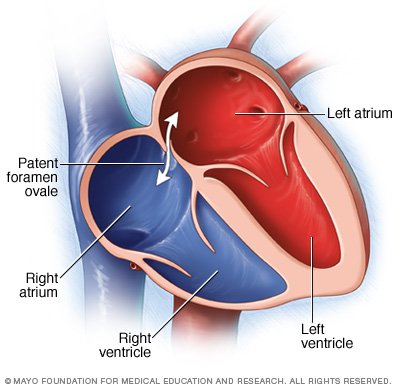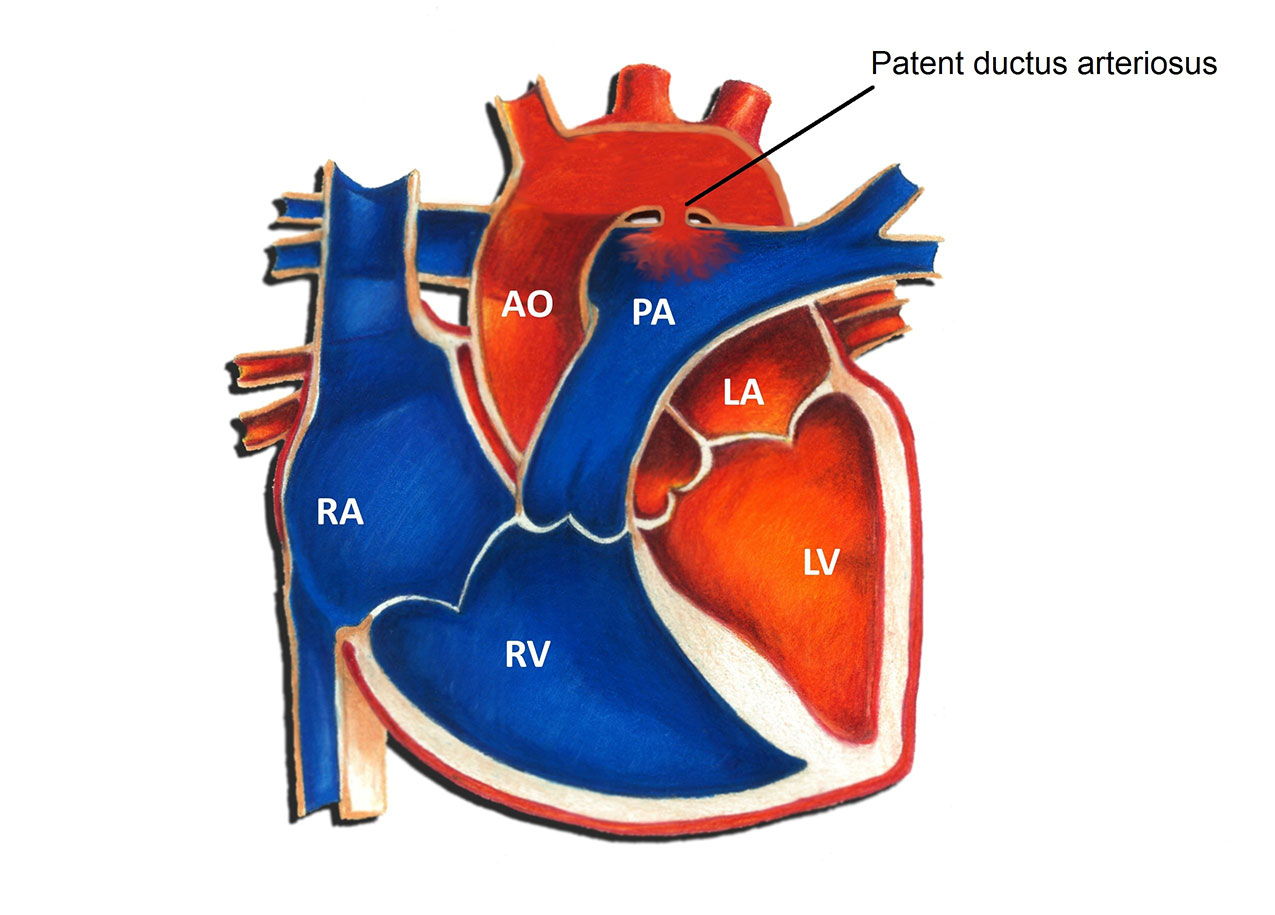How does the heart change at birth?
When a baby is born, there are rapid changes in the heart that occur. This is due to the very different demands of the heart when a baby is breathing air normally upon birth or when receiving oxygenated blood from their mother in utero.
In the mother’s uterus, the foetus is not required to breathe, because it receives oxygenated blood from the mother’s circulation via the umbilical cord. The foetus is also surrounded by amniotic fluid, meaning his or her lungs remain deflated. This creates a great amount of resistance for blood flowing from the heart to the lungs, which ultimately results in blood having to bypass the lungs via two shunts. In order to understand these circulatory shunts we must first look at the a diagram of the adult heart and understand the roles of each of the chambers (shown below in figure 1).

figure 1. Adult heart
In a normal adult heart deoxygenated blood arrives from the body at the right atrium and passes through a tricuspid valve into the right ventricle. From here it is ejected via the pulmonary artery to the lungs. The lungs subsequently add oxygen and remove carbon dioxide from the blood, which returns as oxygenated blood to the heart via the pulmonary vein. After leaving the pulmonary vein oxygenated blood enters the heart through the left atrium, passing through the mitral (or bicuspid) valve to the left ventricle. The left ventricle then pumps oxygen rich blood up through the aorta to the body. The body then uses the oxygen within this oxygen rich blood to carry out aerobic respiration.
Shunts of the foetal circulation
There are two major shunts of the foetal circulation in order to bypass the deflated lungs. The first is the foramen ovale, whichi is shown in figure 2 below.

figure 2. Foramen ovale
This allows blood in the foetus to bypass the lungs and move from the right atrium into the left atrium, to be circulated around the body.
The second shunt is the ductus arteriosus, which is shown in figure 3 below.

figure 3. Ductus arteriosus
This is a shunt from the pulmonary artery to the aorta, and much like the foramen ovale, is used to bypass the deflated lungs of the foetus. Both these shunts described are extremely useful in the foetus in order to allow the rest of its body to receive blood from the heart and not get trapped by the deflated lungs.
But why do these shunts need to close at birth?
It may not be obvious as to what problem these shunts can present to an adult person if they remain open. The answer is all to do with pressure difference!
In the foetus the collapsed lungs give a very high pressure on the right side of the heart. Those physicists among the readers will know the fluids move from high pressure to low pressure if given the opportunity. This means in the foetus, blood moves from the right atrium to left atrium through the foramen ovale, and from pulmonary artery to aorta through the ductus arteriosus. We have no problems at all as blood is bypassing the lungs!
However, when you are born, your lungs inflate (obviously), and this reduces the pressure on the right side of the heart to below the left side. This will mean blood will move from the left side to the right side from high to low pressure. Oxygenated blood will move from the left atrium to right atrium through the foramen ovale and from the aorta to pulmonary artery via the ductus arteriosus.
Hang on, this still isn’t a problem is it?
Correct. Oxygenated blood is just mixing with deoxygenated blood, so we currently do not have a problem in the short term. However, as there is more blood flowing through the right side of the heart, it has to work harder and harder. Eventually the right heart muscle will grow and the pressure will rise, pumping blood into the left side of the heart again, mixing deoxygenated blood into oxygenated blood. Now we have a problem. The body will not be getting enough oxygenated blood and may not be able to function properly, and you will get cyanosis. This is a blue tinge to the skin, lips and nail beds due to lack of oxygenation of tissues.
So, how do these shunts close?
This is relatively simple! Due to the pressure differences at birth, when the lungs inflate a flap is pushed over the foramen ovale to close it as the pressure in the left atrium increases. The ductus arteriosus is closed by decreasing prostaglandin levels in the mother and the release of bradykinin from the lungs (these are both hormones).
References:
http://www.stanfordchildrens.org/en/topic/default?id=blood-circulation-in-the-fetus-and-newborn-90-P02362
https://pediatricheartspecialists.com/heart-education/15-congenital-heart-defects/172-patent-ductus-arteriosus
http://www.embryology.ch/anglais/pcardio/umstellung02.html
Wow, love your very informative posts, and in layman terms as well!!
Thank you so much. This is exactly what I am attempting to do!
Join us on #steemSTEM / Follow our curation trail on Streemian
Thank you for this very interesting article. It has been advertised on our chat channel (and upvoted).
The steemSTEM project is a community-supported project aiming to increase the quality and the visibility of STEM (STEM is the acronym for Science, Technology, Engineering and Mathematics) articles on Steemit.
Congratulations @ovij! You have completed some achievement on Steemit and have been rewarded with new badge(s) :
Click on any badge to view your own Board of Honor on SteemitBoard.
For more information about SteemitBoard, click here
If you no longer want to receive notifications, reply to this comment with the word
STOPCrazy new knowledge brought to me for the first time :o
I never knew that human fetuses had these shunts. Very cool to learn this info!
Thank you, much appreciated!
Great informative post. Upvoted
Great post! Very informative! I read somewhere that the babies heart valve gets closed when baby receives all the blood from the placenta then a hormone is released and bam shut switch over happens... something like that. Love learning more! Thanx for sharing!
The two valves I mentioned in this article are closed by different mechanisms. The foramen ovale shuts simply due to pressure changes in the babies heart upon birth. However the ductus arteriosus is closed due to hormone involvement much like you describe. It is more a decrease in hormones as the baby is unattached from the mother that causes the shunt to close though.
Wow! Ok! Thank you for the further explanation! Once again wonderful article!
Very interesting - isn't the way we are created just amazing?
The complexity of the human body is remarkable. When looking at development and embryology it is amazing how many processes must be correct, yet they are correct the majority of the time!